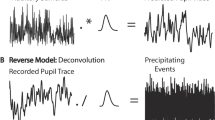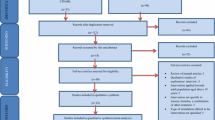Abstract
Stochastic resonance (SR) is a phenomenon whereby the response of a non-linear system to a weak periodic input signal is optimized by the presence of a particular non-zero level of noise. Stochastic resonance using imperceptible stochastic vestibular electrical stimulation, when applied to normal young and elderly subjects, has been shown to significantly improve ocular stabilization reflexes in response to whole-body tilt; improved balance performance during postural disturbances and optimize covariance between the weak input periodic signals introduced via venous blood pressure receptors and the heart rate responses. In our study, 15 subjects stood on a compliant surface with their eyes closed. They were given low-amplitude binaural bipolar stochastic electrical stimulation of the vestibular organs in two frequency ranges of 1–2 and 0–30 Hz over the amplitude range of 0 to ±700 μA. Subjects were instructed to maintain an upright stance during 43-s trials, which consisted of baseline (zero amplitude) and stimulation (non-zero amplitude) periods. Measures of stability of the head and trunk using inertial motion unit sensors attached to these segments and the whole body using a force plate were measured and quantified in the mediolateral plane. Using a multivariate optimization criterion, our results show that the low levels of vestibular stimulation given to the vestibular organs improved balance performance in normal healthy subjects in the range of 5–26% consistent with the stochastic resonance phenomenon. In our study, 8 of 15 and 10 of 15 subjects were responsive for the 1–2- and 0–30-Hz stimulus signals, respectively. The improvement in balance performance did not differ significantly between the stimulations in the two frequency ranges. The amplitude of optimal stimulus for improving balance performance was predominantly in the range of ±100 to ±400 μA. A device based on SR stimulation of the vestibular system might be useful as either a training modality to enhance adaptability or skill acquisition, or as a miniature patch-type stimulator that may be worn by people with disabilities due to aging or disease to improve posture and locomotion function.





Similar content being viewed by others
References
Aihara T, Kitajo K, Nozaki D, Yamamoto Y (2010) How does stochastic resonance work within the human brain?—psychophysics of internal and external noise. Chem Phys. doi:10.1016/j.chemphys.2010.04.027
Cauquil SA, Faldon M, Popov K, Day BL, Bronstein AM (2003) Short-latency eye movements evoked by near-threshold galvanic vestibular stimulation. Exp Brain Res 148:414–418. doi:10.1007/s00221-002-1326-z
Collins JJ, Chow CC, Imhoff TT (1995) Stochastic resonance without tuning. Nature 376(6537):236–238
Collins JJ, Imhoff TT, Grigg P (1996a) Noise-enhanced information transmission in rat SA1 cutaneous mechanoreceptors via aperiodic stochastic resonance. J Neurophysiol 76(1):642–645
Collins JJ, Imhoff TT, Grigg P (1996b) Noise-enhanced tactile sensation. Nature 383:770
Collins JJ, Imhoff TT, Grigg P (1997) Noise-mediated enhancements and decrements in human tactile sensation. Phys Rev E 56:923–926
Collins JJ, Priplata AA, Gravelle DC, Niemi J, Harry J, Lipsitz LA (2003) Noise-enhanced human sensorimotor function. IEEE Eng Med Biol Mag 22(2):76–83
Cordo P, Inglis JT, Verschueren S, Collins JJ, Merfeld DM, Rosenblum S, Buckley S, Moss F (1996) Noise in human muscle spindles. Nature 383:769–770
Dakin CJ, Son GML, Inglis JT, Blouin J-S (2007) Frequency response of human vestibular reflexes characterized by stochastic stimuli. J Physiol 583(3):1117–1127
Douglass JK, Wilkens L, Pantazelou E, Moss F (1993) Noise enhancement of information transfer in crayfish mechanoreceptors by stochastic resonance. Nature 365(6444):337–340
Faisal AA, Selen LPJ, Wolpert DM (2008) Noise in the nervous system. Nat Rev Neurosci 9(4):292–303
Fallon JB, Carr RW, Morgan DL (2004) Stochastic resonance in muscle receptors. J Neurophysiol 91(6):2429–2436
Fitzpatrick R, Burke D, Gandevia SC (1996) Loop gain of reflexes controlling human standing measured with the use of postural and vestibular disturbances. J Neurophysiol 76:3994–4008
Geraghty MC, Deegan BM, Wood SJ, Serrador JM (2008) Enhancement of vestibular ocular counter-roll with subthreshold stochastic resonance galvanic stimulation. 19th international symposium on the autonomic nervous system, Kauai, Hawaii, October 29–November 1, 2008
Gravelle DC, Laughton CA, Dhruv NT, Katdare KD, Niemi JB, Lipsitz LA, Collins JJ (2002) Noise-enhanced balance control in older adults. Neuroreport 13:1853–1856
Hidaka I, Nozaki D, Yamamoto Y (2000) Functional stochastic resonance in the human brain: noise induced sensitization of baroreflex system. Phys Rev Lett 85(17):3740–3743
Hlavacka F, Njiokiktjien C (1985) Postural responses evoked by sinusoidal galvanic stimulation of the labyrinth. Acta Otolaryngol 99:107–112
Ivey C, Apkarian AV, Chialvo DR (1998) Noise-induced tuning curve changes in mechanoreceptors. J Neurophysiol 79:1879–1890
Kim J, Curthoys IS (2004) Responses of primary vestibular neurons to galvanic vestibular stimulation (GVS) in the anaesthetised guinea pig. Brain Res Bull 64:265–271
Kitajo K, Nozaki D, Ward LM, Yamamoto Y (2003) Behavioral stochastic resonance within the human brain. Phys Rev Lett 90:218103
Levin JE, Miller JP (1996) Broadband neural encoding in the cricket cercal sensory system enhanced by stochastic resonance. Nature 380(6570):165–168
MacDougall HG, Moore ST, Curthoys IS, Black FO (2006) Modeling postural instability with galvanic vestibular stimulation. Exp Brain Res 172(2):208–220
Manjarrez E, Rojas-Piloni G, Mendez I, Flores A (2003) Stochastic resonance within the somatosensory system: effects of noise on evoked field potentials elicited by tactile stimuli. J Neurosci 23:1997–2001
McDonnell MD, Abbott D (2009) What is stochastic resonance? Definitions, misconceptions, debates, and its relevance to biology. PLoS Comput Biol 5(5): e1000348. doi:10.1371/journal.pcbi.1000348
Moore ST, MacDougall HG, Peters BT, Bloomberg JJ, Curthoys IS, Cohen HS (2006) Modeling locomotor dysfunction following spaceflight with galvanic vestibular stimulation. Exp Brain Res 174(4):647–659
Moss F, Ward LM, Sannita WG (2004) Stochastic resonance and sensory information processing: a tutorial and review of application. Clin Neurophysiol 115(2):267–281
Mulavara AP, Cohen HS, Bloomberg JJ (2009) Critical features of training that facilitate adaptive generalization of over ground locomotion. Gait Posture 29:242–248
Mulavara AP, Feiveson A, Feidler J, Cohen HS, Peters BT, Miller CA, Brady R, Bloomberg JJ (2010) Locomotor function after long duration spaceflight: effects and motor learning during recovery. Exp Brain Res May; 202(3):649–659. Epub 2010 Feb 5
Nashner LM, Shupert CL, Horak FB, Black FO (1989) Organization of posture controls: an analysis of sensory and mechanical constraints. Prog Brain Res 80:411–418
Pal S, Rosengren SM, Colebatch JG (2009) Stochastic galvanic vestibular stimulation produces a small reduction in sway in Parkinson’s disease. J Vestib Res 19:137–142
Pavlik AE, Inglis JT, Lauk M, Oddsson L, Collins JJ (1999) The effects of stochastic galvanic vestibular stimulation on human postural sway. Exp Brain Res 124(3):273–280
Peterka RJ (2002) Sensorimotor integration in human postural control. J Neurophysiol 88:1097–1118
Peterka RJ, Loughlin PJ (2004) Dynamic regulation of sensorimotor integration in human postural control. J Neurophysiol 91:410–423
Piana M, Canfora M, Riani M (2000) Role of noise in image processing by the human perceptive system. Phys Rev E Stat Phys Plasmas Fluids Relat Interdiscip Topics 62:1104–1109
Priplata A, Niemi J, Salen M, Harry J, Lipsitz LA, Collins JJ (2002) Noise enhanced balance control. Phys Rev Lett 89:238101.1–238101.4
Priplata AA, Niemi JB, Harry JD, Lipsitz LA, Collins JJ (2003) Vibrating insoles and balance control in elderly people. Lancet 362: 1123–1124
Priplata AA, Patritti BL, Niemi JB, Hughes R, Gravelle DC, Lipsitz LA, Veves A, Stein J, Bonato P, Collins JJ (2006) Noise-enhanced balance control in patients with diabetes and patients with stroke. Ann Neurol 59:4–12
Reeves NP, Cholewicki J, Lee AS, Mysliwiec LW (2009) The effects of stochastic resonance stimulation on spine proprioception and postural control in chronic low back pain patients. Spine 34(4):316–321
Riani M, Simonotto E (1994) Stochastic resonance in the perceptual interpretation of ambiguous figures: a neural network model. Phys Rev Lett 72:3120–3123
Richardson KA, Imhoff TT, Grigg P, Collins JJ (1998) Using electrical noise to enhance the ability of humans to detect subthreshold mechanical cutaneous stimuli. Chaos 8(3):599–603
Scinicariello AP, Inglis JT, Collins JJ (2002/2003) The effects of stochastic monopolar galvanic vestibular stimulation on human postural sway. J Vestib Res 12:77–85
Simonotto E, Riani M, Seife C, Roberts M, Twitty J, Moss F (1997) Visual perception of stochastic resonance. Phys Rev Lett 78:1186–1189
Soma R, Nozaki D, Kwak S, Yamamoto Y (2003) 1/f Noise outperformswhite noise in sensitizing baroreflex function in the human brain. Phys Rev Lett 91(7):078101-1–4
Songer JE, Eatock RA (2010) Frequency characteristics of the mammalian saccular epithelium. NASA Human Research Program Investigators’ Workshop February 3–5, 2010. Houston, Texas
Ward LM, Desai S, Rootman D, Tata MS, Moss F (2001) Noise can help as well as hinder seeing and hearing. Bull Am Phys Soc 46:N23.002. Full paper at: http://www.aps.org/meet/MAR01/baps/vpr/layn23-002.html
Yamamoto Y, Struzik ZR, Soma R (2005) Noisy vestibular stimulation improves autonomic and motor responsiveness in central neurodegenerative disorders. Ann Neurol 58:175–181
Zeng F-G, Fu Q-J, Morse R (2000) Human hearing enhanced by noise. Brain Res Interact 869:251–255
Acknowledgments
This study was supported in part by a grant from the National Space Biomedical Research Institute through NASA NCC 9-58 (SA02001) to Ajitkumar Mulavara (PI). We would like to thank Erin Heap, Keena Acock, and Elizabeth Fisher for their help with data analysis and data collection and Hamish MacDougal and John Holden for their help with design and building the vestibular stimulation system. We would also like to thank all the subjects who participated voluntarily in the experiments.
Author information
Authors and Affiliations
Corresponding author
Rights and permissions
About this article
Cite this article
Mulavara, A.P., Fiedler, M.J., Kofman, I.S. et al. Improving balance function using vestibular stochastic resonance: optimizing stimulus characteristics. Exp Brain Res 210, 303–312 (2011). https://doi.org/10.1007/s00221-011-2633-z
Received:
Accepted:
Published:
Issue Date:
DOI: https://doi.org/10.1007/s00221-011-2633-z




